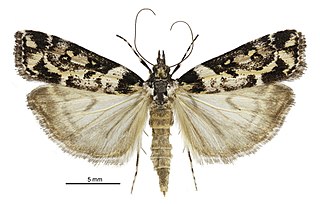Flexiptera is a monotypic moth genus in the family Gelechiidae erected by Anthonie Johannes Theodorus Janse in 1958. Its only species, Flexiptera revoluta, was first described by Edward Meyrick in 1918. It is found in South Africa.

Eudonia diphtheralis is a species of moth in the family Crambidae. It is endemic to New Zealand.
Dichomeris praevacua is a moth in the family Gelechiidae. It was described by Edward Meyrick in 1922. It is found in Shanghai, China.
Scrobipalpa blapsigona is a moth in the family Gelechiidae. It was described by Edward Meyrick in 1916. It is found in southern India and Bengal.
Scrobipalpula crustaria is a moth in the family Gelechiidae. It was described by Edward Meyrick in 1917. It is found in Peru.
Epimimastis emblematica is a moth in the family Gelechiidae. It was described by Edward Meyrick in 1916. It is found in Assam, India.
Ornativalva mixolitha is a moth of the family Gelechiidae. It was described by Edward Meyrick in 1918. It is found in Morocco, Algeria, Tunisia, southern Russia, Turkey, Sudan, Iraq, Iran, Afghanistan, Pakistan, India (Bihar) and Mongolia.
Autosticha bilobella is a moth in the family Autostichidae. It was described by Kyu-Tek Park and Chun-Sheng Wu in 2003. It is found in Guangdong, China.
Autosticha petrotoma is a moth in the family Autostichidae. It was described by Edward Meyrick in 1916. It is found in Sri Lanka.
Autosticha relaxata is a moth in the family Autostichidae. It was described by Edward Meyrick in 1916. It is found in Sri Lanka.
Autosticha spilochorda is a moth in the family Autostichidae. It was described by Edward Meyrick in 1916. It is found in southern India.
Autosticha xanthographa is a moth in the family Autostichidae. It was described by Edward Meyrick in 1916. It is found in Sri Lanka.
Autosticha crocothicta is a moth in the family Autostichidae. It was described by Edward Meyrick in 1916. It is found in Sri Lanka.
Autosticha exemplaris is a moth in the family Autostichidae. It was described by Edward Meyrick in 1916. It is found in southern India.
Autosticha iterata is a moth in the family Autostichidae. It was described by Edward Meyrick in 1916. It is found in Sri Lanka.
Autosticha vicularis is a moth in the family Autostichidae. It was described by Edward Meyrick in 1911. It is found in Sri Lanka.
Autosticha encycota is a moth in the family Autostichidae. It was described by Edward Meyrick in 1922. It is found in Chennai, India.
Prothamnodes platycycla is a moth in the family Xyloryctidae. It was described by Edward Meyrick in 1923. It is known from Myanmar.
Antaeotricha deridens is a moth in the family Depressariidae. It was described by Edward Meyrick in 1925. It is found in Bolivia.
Moca aphrodora is a species of moth in the family Immidae first described by Edward Meyrick in 1922. It is found in Brazil and Peru.
